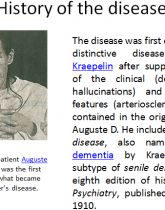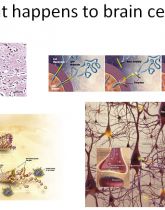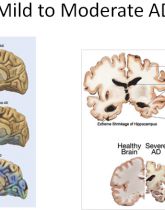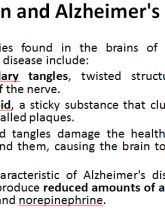Prezentace: Pharmacotherapy of Alzheimer disease
Skrýt detaily | Oblíbený- Kvalita:84,5 %
- Typ:Prezentace
- Univerzita:Veterinární a farmaceutická univerzita Brno
- Fakulta:Farmaceutická fakulta
- Kategorie:Přírodní vědy
- Podkategorie:Zdravotnictví, lékařství
- Předmět:Famrakologie
- Studijní obor:Farmakologie
- Autor:stefan.potocky
- Ročník:3. ročník
- Rozsah A4:56 strán
- Zobrazeno:1 393 x
- Stažené:0 x
- Velikost:1,4 MB
- Formát a přípona:MS Office PowerPoint (.ppt)
- Jazyk:anglický
- ID projektu:5616
- Poslední úprava:20.04.2015
Alzheimer
The most common form of dementia among older people is Alzheimer’s disease in which there is neurodegeneration leads to memory loss. About 4.5 million Americans suffer from this condition, which usually begins after age 60.
The Brain and Alzheimer's Disease
Abnormalities found in the brains of people with Alzheimer's disease include:
Neurofibrillary tangles, twisted structures formed from part of the nerve.
Beta amyloid, a sticky substance that clumps to form structures called plaques.
Plaques and tangles damage the healthy brain cells that surround them, causing the brain to waste away and shrink.
Another characteristic of Alzheimer's disease is that brain cells produce reduced amounts of acetylcholine, serotonin, and norepinephrine.
What is Tau?
Tau, which usually has a certain number of phosphate molecules attached to it, binds to microtubules and appears to stabilize them.
In AD, an abnormally large number of additional phosphate molecules attach to tau. As a result of this “hyperphosphorylation,” tau disengages from the microtubules and begins to come together with other tau threads. These tau threads form structures called paired helical filaments, which can become enmeshed with one another, forming tangles within the cell.
The microtubules can disintegrate in the process, collapsing the neuron’s internal transport network. This collapse damages the ability of neurons to communicate with each other.
The most common form of dementia among older people is Alzheimer’s disease in which there is neurodegeneration leads to memory loss. About 4.5 million Americans suffer from this condition, which usually begins after age 60.
The Brain and Alzheimer's Disease
Abnormalities found in the brains of people with Alzheimer's disease include:
Neurofibrillary tangles, twisted structures formed from part of the nerve.
Beta amyloid, a sticky substance that clumps to form structures called plaques.
Plaques and tangles damage the healthy brain cells that surround them, causing the brain to waste away and shrink.
Another characteristic of Alzheimer's disease is that brain cells produce reduced amounts of acetylcholine, serotonin, and norepinephrine.
What is Tau?
Tau, which usually has a certain number of phosphate molecules attached to it, binds to microtubules and appears to stabilize them.
In AD, an abnormally large number of additional phosphate molecules attach to tau. As a result of this “hyperphosphorylation,” tau disengages from the microtubules and begins to come together with other tau threads. These tau threads form structures called paired helical filaments, which can become enmeshed with one another, forming tangles within the cell.
The microtubules can disintegrate in the process, collapsing the neuron’s internal transport network. This collapse damages the ability of neurons to communicate with each other.




